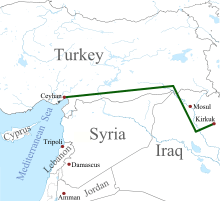Kirkuk–Ceyhan Oil Pipeline
| Kirkuk–Ceyhan Oil Pipeline | |
|---|---|
 Location of Kirkuk–Ceyhan Oil Pipeline | |
| Location | |
| Country | Iraq, Turkey |
| General direction | east-west |
| From | Kirkuk, Iraq |
| To | Ceyhan, Turkey |
| General information | |
| Type | oil |
| Commissioned | 1970 |
| Technical information | |
| Length | 600 mi (970 km) |
| Maximum discharge | 1.6 million barrels per day (250×103 m3/d) |
Kirkuk–Ceyhan Oil Pipeline (also: Iraq–Turkey Crude Oil Pipeline) is a 600-mile (970 km) long pipeline. It is Iraq's largest crude oil export line.
Technical description
The pipeline consists two pipes with diameters of 46 inches (1,170 mm) and 40 inches (1,020 mm) and designed capacity of 1,100 thousand and 500 thousand barrels per day (~5.5×107 and ~2.5×107 t/a) respectively. Usable capacity of the line is believed to be only 300 thousand barrels per day (~1.5×107 t/a), with significant repairs still required.[1]
Incidents of sabotage
The line's Iraqi part has been a principal sabotage target since 2003.[2] On 26 October 2009, the blast near Mosul halted oil supplies through the pipeline.[3] On 16 August 2013, at around 0100 GMT near the al-Shura area 60 km to the south of the city of Mosul a bomb attack damaged the pipeline.[4] On 3 September 2013, at around 0200 GMT near Ein al-Jahash area, a bomb attack damaged the pipeline.[5]
Kurdistan Pipeline
In 2013, the Kurdistan Regional Government of Iraq completed a pipeline from the Taq Taq field through Khurmala (the northwest sector dome of the greater Kirkuk field) and Dahuk to Pesh Khabur (Fesh Khabur) on the Turkey-Iraq border, where it is connected to the Kirkuk-Ceyhan pipeline. This 36-inch (910 mm) diameter pipeline has capacity of 150,000 barrels per day (24,000 m3/d). It allows the export of oil from the Taq Taq and Tawke oil fields.[6] On 23 May 2014, the Kurdistan Regional Government announced that the first oil transported via the new pipeline was loaded into a tanker at Ceyhan.[7]
New pipeline proposal
Iraq is considering building a new Kirkuk–Ceyhan pipeline to bypass attack-prone areas and double the export capacity.[8]
See also
References
- ↑ "Gulf states mull over Hormuz bypass". Upstream Online. NHST Media Group. 2007-05-11. Retrieved 2008-03-08.
- ↑ "Explosion at fuel pipeline west of Baghdad". USA Today. 2003-06-22. Retrieved 2008-03-08.
- ↑ "Blast rocks Kirkuk export link". Upstream Online. NHST Media Group. 2009-10-28. Retrieved 2009-10-28.
- ↑ "Iraq-Turkey oil pipeline bombed: officials". Reuters. 2013-08-16.
- ↑ "Bomb attack halts Kirkuk-Ceyhan pipeline crude flow". The Peninsula Qatar (newspaper). Dar Al-Sharq. 2013-09-03. Retrieved 2013-09-03.
- ↑ "Operations in Kurdistan Region of Iraq". Genel Energy. Retrieved 2014-06-14.
- ↑ "KRG statement on first oil sales through pipeline export" (Press release). Kurdistan Regional Government. 2014-05-23. Retrieved 2014-06-14.
- ↑ Coskun, Orhan (2014-04-09). "Iraq wants to raise Kirkuk-Ceyhan oil flow above 1 mln bpd-minister". Reuters. Retrieved 2014-06-16.